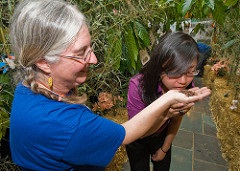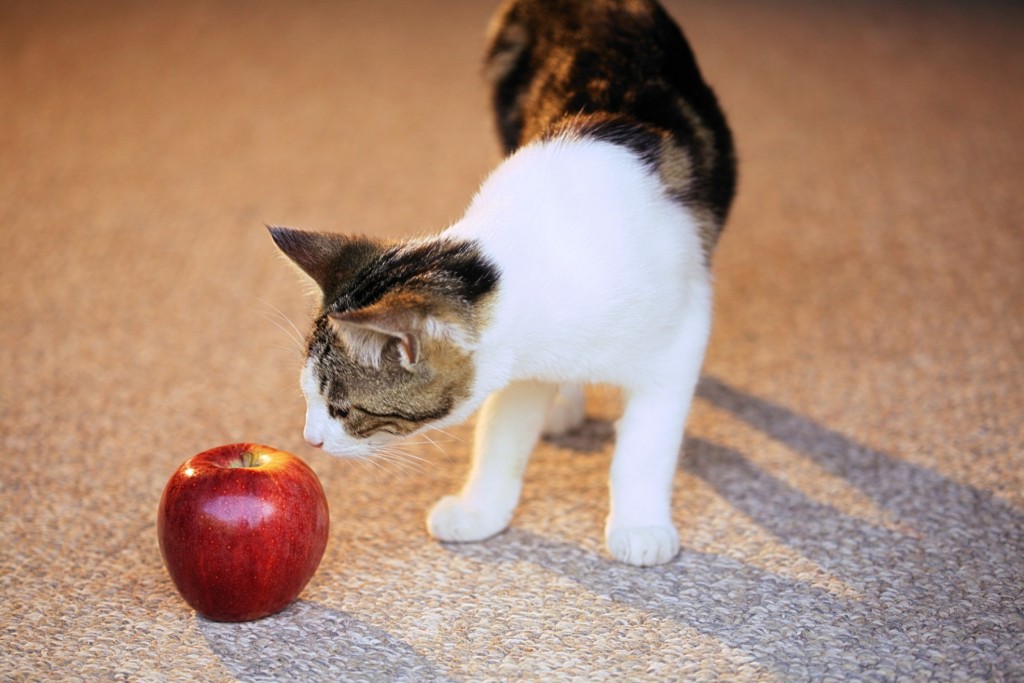A Tasty Experiment
Activity from Teachengineering.org is part of a lesson on the importance of smell developed by Duke University’s Pratt School of Engineering.
Grade level: 3-7
Time: 90 minutes
Summary
Student teams in grades 3 to 7 learn the key role that smell plays in being able to recognize foods by conducting taste tests while holding and not holding their noses. They then create bar graphs comparing the number of correct identifications for the two experimental conditions.
Engineering Connection
Standards
Next Generation Science Standards
Use a model to describe that animals’ receive different types of information through their senses, process the information in their brain, and respond to the information in different ways. [Grade 4]
Common Core State Standards for Mathematics
- Draw a scaled picture graph and a scaled bar graph to represent a data set with several categories. Solve one- and two-step “how many more” and “how many less” problems using information presented in scaled bar graphs. For example, draw a bar graph in which each square in the bar graph might represent 5 pets. [Grade 3]
International Technology and Engineering Educators Association
- Compare, contrast, and classify collected information in order to identify patterns. [Grades 3 – 5]
Prerequisite Knowledge
- An understanding of what a biological adaptation is.
- Ability to construct a bar graph (helpful, but not essential).
Learning Objectives
After this activity, students should be able to:
- Explain the importance of the sense of smell to the ability of humans to recognize familiar foods.
- Explain why it is adaptive for an animal to use its sense to identify food as being either nutritious or noxious.
- Create and interpret bar graphs comparing quantities of different items

Image: USDA scientist Mary Strem with visitor smelling cocoa husks at the Sustainable Perennial Crop Lab in Beltsville, Md.
Materials List
- Yogurt or pudding, 4 different flavors, 8 to 12 ounces each (use the larger amount for class sizes greater than 24); if using yogurt, choose types that are “blended” and do not contain bits of fruit that might provide clues due to texture. It is not necessary to have all four flavors be either yogurt or pudding; for example, it would be fine to have two different flavors of yogurt and two different flavors of pudding. Note: See the Safety Issues section regarding food allergies.
- 4 cup or bowls capable of holding at least 8 ounces
- ~100 plastic spoons
- 4 watches with second hands
- 4 cardboard shoe boxes or similarly sized boxes without lids
- 4 towels, t-shirts or pieces of fabric that are just large enough to drape over the boxes
- 4 trash receptacles
- 16 copies of the Tasty Experiment Datasheet, give each group four datasheets, one for each of the four stations
Introduction/Motivation
Procedure
- Make sure all students know how to use the watches to determine when 15 seconds have elapsed. Explain that this is the amount of time that students are allowed before they must state the flavor of the food they just tasted—or else state that they are unable to identify it. Since students take turns being the timers, everyone must be able to determine when 15 seconds have elapsed.
- Explain the basic procedure for the experiment, as follows:
- Make sure that all students know how to fill in the datasheet, starting with identifying the tasting station number, and then listing the names of the team members that hold their noses in the left column. They enter the names of the team members that do the tasting without holding their noses into the third column, and once the taste-testing begins, they enter response of each student into the appropriate “Response” column. If the taster does not give a response within the 15 seconds, the response is recorded as “none.”
- Divide the class into fourths, with each quarter comprising a team. If necessary, ask for help in rearranging the classroom to set up the four tasting stations.
- At each station place one-fourth of the spoons, a trash receptacle for the used spoons, a watch and a box containing a cup or bowl of food to be tasted, but cover the box with the fabric while it is in transit so that students are not able to see its contents. Also place a copy of the datasheet at each station, and a placard with a number between one and four to indicate the number of that particular tasting station.
- Have each team choose two of its members to serve as the timer and the presenter for the first station. Have the remaining team members decide which half to hold their noses and close their eyes, and which half to only close their eyes. For teams with an odd number of students, have the extra student hold his or her nose and close his or her eyes while tasting. Be sure to explain that as they rotate through the different stations, every student will have an opportunity to do both types of tastings, and most will have an opportunity to be the presenter and/or the timer.
Body of Activity:
Part 1: Doing the taste tests
Part 2: Graphing and interpreting the data
Part 3: Relating the experiment to human adaptations
After this brief discussion of adaptive behavior, ask the class a harder question: what is the difference between the sense of taste and the sense of smell? Give them some time to share their opinions, and then draw a map of the tongue’s upper surface on the board, showing the regions that respond to the sweet, salty, sour, and bitter aspects of food. Then ask the class how the tongue can distinguish between different flavors of pudding, which are all sweet, if it has only the ability to distinguish between, say, sweet versus salty foods? Since it can’t, explain how the sense of smell works, especially as it relates to eating. Finally, conclude the activity and lesson by pointing out that not only is food tasting behavior adaptive, but the structures that allow us to taste foods—which includes smell—are adaptations of the body that have helped humans survive for thousands of years.
Attachments
Safety Issues
- Check for food allergies well in advance of the activity. Since the quantity of dairy products involved in the tasting experiment is extremely small, this should not be a problem for students with lactose intolerances. Nevertheless, consult with parents if you do have lactose-intolerant students in the class. If you are advised not to allow them to participate, substitute pureed fruit baby food products for the experiment.
- Make sure all surfaces in the tasting areas are scrupulously clean before beginning.
- All students should wash their hands thoroughly before and after serving as “feeders.” You may provide bottles of liquid hand-sanitizer at each station as an alternative, but be sure to check that students use them in such as way as to be effective.
Troubleshooting Tips
- Make sure that students state their food identification responses before they release their noses for the not-able-to-smell components of the tastings. Responses given after releasing their noses should not be counted as correct responses, but instead should be marked on the datasheets as “none.”
- Demonstrate the correct amount of food (about one-half to three-quarters of a teaspoon) that feeders should put on the spoon; if they use too much it may slide off the spoon before it reaches the taster’s mouth, or the food may run out before the end of the experiment.
- Remind students not to share information about what a food is with students who have not yet had an opportunity to taste it.
- Emphasize that the point of the experiment is not to get the food answers “right,” but to find out if it is harder to tell what a food is if you can’t smell it. Then ask if this information about the sense of smell is consistent with the results they got in their experiment. To use a pun, does it make sense that food identification is difficult or impossible without the sense of smell?
Investigating Questions
- What do you notice about the responses so far?
- Are students more successful at identifying the foods when they can smell them? If so, is there a big difference in the number of correct responses between the able-to-smell versus not-able-to-smell groups, or is it only a small difference?
- So far, does it look like your hypothesis is going to be supported?
- Do the foods at some stations seem more difficult to identify than the foods at other stations? If so, why do you think that might be?
- Why do many people complain that when they have a bad cold that food seems to lose its taste?
Assessment
- A fellow student tells you that he is going to give you either a piece of a plain brownie, or a piece of a brownie containing walnuts, but you have to close your eyes and hold your nose while you chew and swallow it. If you can correctly identify which piece he has given you, he will then give you the rest of the brownie. Do you think you will be able to correctly identify which piece he has given you? Why do you think that?
- Another student tells you that she is going to give you either a spoonful of cherry Jello® or a spoonful of orange Jello®. However, if you want more than a spoonful, you will have to close your eyes and hold your nose while you eat it, and then correctly identify the flavor. Do you think you will be able to do it? Why do you think that?
- Why do some people think that food has less flavor when they have a stuffy nose from a bad cold?
- Create a bar graph similar to the ones students created, but showing the results of a different experiment, such as the one shown in the attachment test-graph.gif. Then ask the following questions:
- What was the total number of correct answers given by students who studied for the spelling test?
- What was the total number of incorrect answers given by students who studied for the spelling test?
- What was the total number of correct answers given by students who did not study for the spelling test?
- What was the total number of incorrect answers given by students who did not study for the spelling test?
- What can you conclude from this experiment?
- What hypothesis do you think this experiment was testing?
Activity Extensions
- Flavor Chemistry. ChemMatters video on the science behind the taste and smell of food [YouTube 5:05]
- How Flavor Chemists Make Food so Addictively Good. It can take more than 300 individual compounds to create a ripe-strawberry flavor and other fun facts about flavor engineers.
- Smell and Taste: Spice of Life A brief look at our sense of smell and what causes us to lose it as we age from the National Institute on Aging.
- Flavor-shifting Ice Cream! eGFI students’ blog post on the University of Missouri’s next-generation frozen dairy treats.
References
Hebrank, M.R., 1995. “An Exercise in Good Taste,” in Biology on a Shoestring, National Association of Biology Teachers, Reston, VA.
Contributors
Mary R. Hebrank, project and lesson/activity consultant
Copyright © 2013 by Regents of the University of Colorado; original © 2004 Duke University
Filed under: Class Activities, Grades 6-8, Grades 6-8, Grades K-5, Lesson Plans
Tags: bar chart, CCSS, Chemical Engineering, Class Activities, flavor engineering, food, food engineering, Grades 6-8, Grades K-5, NGSS, senses, smell, taste









